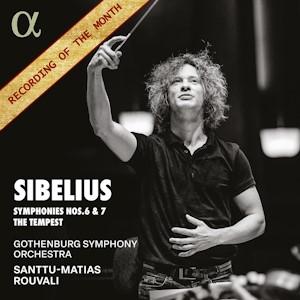
Jean Sibelius (1865-1957)
Symphony No. 6 in D minor, Op. 104
Symphony No. 7 in C major, Op. 106
The Tempest, Op. 109 (selection)
Gothenburg Symphony Orchestra/Santtu-Matias Rouvali
rec. 202224, Gothenburg Concert Hall, Sweden
Alpha Classics 1130 [66]
This issue completes Rouvali’s survey of Sibelius’s symphonies on studio recordings for Alpha Classics. My MusicWeb colleagues and I have been mightily impressed with the previous issues (Symphony No. 1; Symphony No. 2; Symphony No. 4; Symphonies 3 & 5 – all “Recommended” and the last both a “Recording of the Month” and one of my Records of the Year 2023).
Naturally, then, I had great expectations of this and I was not disappointed. I adore this music and first listened to the Seventh, as that is always a touchstone for me in any set of Sibelius symphonies and was immediately struck by the depth of sound, both in terms of orchestral playing and engineering. This was hardly a surprise, given my experience of the previous issues but those qualities are crucial to this most atmospheric of works; the next requirement is a sense of inexorably surging forward, like a steadily advancing tide and it is present here in abundance, its motion wonderfully enhanced by snarling brass, trenchant double basses and hard timpani strokes. The first section is marked Adagio, but Rouvali is notably a little more urgent throughout than many of his Big Name rivals such as Ormandy and Karajan – who is the slowest in his earlier, DG recording; he never recorded it for EMI with the BPO but there is a 1955 performance with the Philharmonia on that label, which is very good, tense and driven, but in slightly wiry sound compared with the DG version. Rouvali is here closer to the likes of Davis, Berglund, Beecham and Collins. He moulds the opening phrases carefully, shading dynamics, bringing out that strange, yearning wistful quality of the music, the horns around the four minutes mark really deliver, then he launches into the tripping Vivacissimo, allowing the mellow, rounded tones of the Gothenburg woodwind to shine. They chatter chirpily before the wailing, moaning winds of “storm music” ten minutes, then, by contrast, there is a real lift to the ensuing Presto passage. The big, broad Largamente climax is splendid: stately, grand and yearning; the brass really open up panoramic vistas and the final C major chord peroration glows. The sound of the Gothenburg Orchestra might not be as upholstered as Karajan’s BPO or Ormandy’s Philadelphians but Karajan can seem a little leisurely and indulgent compared with Rouvali’s leaner manner, despite the beauty of his account and their lightness and precision in this mercurial, ever-shape-shifting music are captivating. This is an account worthy to sit alongside Ormandy’s, which has long been my reference recording in this music, as for me he finds the perfect balance between propulsion and tonal sumptuousness; Rouvali is just as good. Having said that, this is a work which has been fortunate on record and I will aways have room for all the versions mentioned above – and for those by Maurice Abravanel (review) and the much-maligned Klaus Mäkelä (review), too.
Whereas Rouvali is a little more urgent than many in the Seventh Symphony, his tempi in the Sixth are conventional, not as fast as Collins, Abravanel and Karajan; surprisingly Karajan is faster than Rouvali by around a minute in all movements but the third and I like the way Rouvali takes a little more time over phrasing. In this regard, he is akin to his younger Finnish contemporary Mäkelä, whose approach is similar to Paavo Berglund’s.
Once again, the sheer beauty of the sound and playing of this new release strike the listener’s ear; there is a melting tenderness to those opening, descending flute figures which seamlessly slips into an exhilarating, moto perpetuo sleigh ride before the shadows gather. Karajan is more aloof, detached and objective in his delivery, which lends the music a kind of silvery perfection, while Rouvali is more emotive. However, both treatments are lovely. The moody, enigmatic second movement is lent greater density before the mood again lightens and the short Poco vivace third movement rattles along engagingly; the bold motif opening the finale rings out emphatically before the typically driven, very Sibelian development which lapses into a reverie and just fades away into the ether – beautifully done.
The incidental music for The Tempest was the composer’s penultimate major work but had had a long gestation; the fifteen-minute selection of instrumental extracts makes an interesting bonus. Their haunting sound-world is highly individual and so typical of Sibelius’ unique idiom, faithfully capturing the magical atmosphere of one of Shakespeare’s most profound plays. Just as Shakespeare had for his last work refined and distilled his language into a simple poetic essence, Sibelius’s music is deceptively naïve and even archaic; the Nymphs’ Dance, for example, sounds like an homage to Renaissance composers in the manner of Respighi but the depiction of Prospero in the brief Largo is much more in the style of say, the Andante festivo: a succession of warm, noble string chords. Every movement is miniature delight – and a surprise; the second Song (Lied II) is a catchy rhythmic Spanish dance for clarinet complete with a backing by castanets – although it is actually the overture to Act V. If this whets your appetite for the complete incidental music, there is a fine recording on Ondine conducted by Jukka-Pekka Saraste with a team of vocal soloists singing in the original Danish. It is available from Presto and you may also hear it on YouTube.
Ralph Moore
Buying this recording via a link below generates revenue for MWI, which helps the site remain free.




















